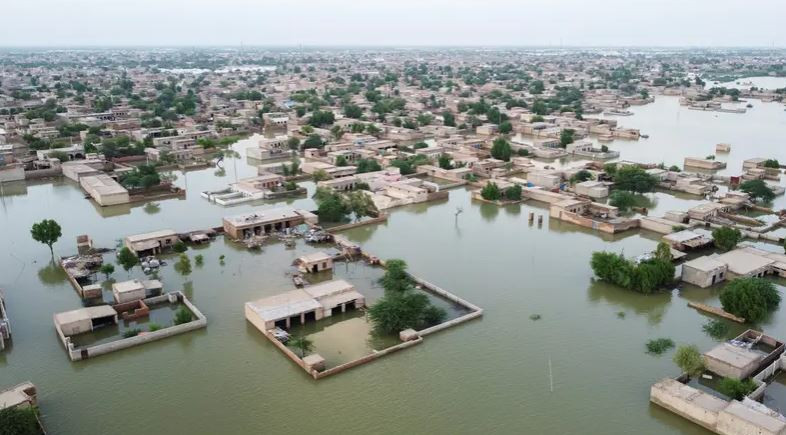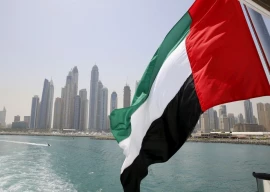
The latest floods in Pakistan are one of the most devastating the world has ever seen.
The current floods are being compared to those of 2010, which according to then UN secretary-general Ban Ki-moon were “the worst such disaster the UN has ever seen”.
The highly respected International Rescue Committee (IRC) believes that the 2022 floods have created more havoc than the 2010 floods.
So far, the death toll from the current floods is estimated to be over 1,160 people, 3,550 injured and 33 million, or 13% of the population, adversely affected.
Over 3,100 km of roads, 149 bridges and 1 million houses have been destroyed. About 2 million acres of crops and 800,000 farm animals have perished.
Damage to the property is still being worked out, but the government estimates that the economic impact would be at least $10 billion, or about 3% of GDP.
In the case of cotton alone, it is estimated that production losses could be 3.24 million bales, or $1.15 billion.
There are many other similarities between the two events. Whereas the 2010 floods had severely dented the GDP growth that reached the low of 2.58%, so has the current flooding, which according to estimates, may bring down the GDP growth level to less than 3%.
Unfortunately, Pakistan’s economy was in relatively poor shape during both episodes. As in 2010, it is again in the middle of an IMF-backed bailout package.
In the aftermath of the 2010 floods, the Punjab government set up Flood Inquiry Tribunal (headed by Justice Mansoor Ali Shah) with a wide-ranging mandate to look at the whole problem and make recommendations.
In its excellent report, the tribunal observed with displeasure that the relevant government agencies have failed to develop an integrated flood management plan.
With input from the experts worldwide, the tribunal recommended moving away from the flawed strategies of “flood control” to more practical and achievable strategies…such as land use zoning, flood plain management, enhancing forest cover along the riverine belt and tampering little with natural river flows.
The tribunal also warned that in the absence of any plan, future monsoon rains coupled with glacial melt could cause ghastly havoc.
Ramsar Advisory Mission (RAM) experts on Wetlands, who visited Pakistan in November 2011, also had similar recommendations. These included setting up a broad-based coordinating authority for an integrated Indus River basin, moving away from the hard‐engineering (or structural) approach and towards soft‐engineering (non‐structural), removing illegal structures, and replanting riverine forests.
Both reports also suggested learning from the Chinese experience of flood management in the 6,300km-long Yangtze River, which used to face recurring floods.
After massive floods in 1998 that killed more than 4,000 people and resulted in economic losses of an estimated $25 billion, the Chinese government decided to change its approach from building civil engineering structures to softer solutions such as reforesting land in the watershed, reclaiming floodplains and restoring wetlands.
Based on these findings and with technical assistance from the Deltares Institute in the Netherlands, Pakistan’s National Engineering Services developed the 4th National Flood Protection Plan (2015-25).
Despite a passage of seven years and clearance by the provincial governments, the federal government’s approval is still pending.
It would be worthwhile to investigate whether to include the plan in CPEC since it will be difficult for our government to implement it independently.
The government has done well in launching the joint “2022 Pakistan Floods Response Plan” with the United Nations.
The response to the recent floods hasn’t so far been as generous as it was after the 2010 floods, when over $4.5 billion was raised. Perhaps one missing element is the absence of the lobbying power of international NGOs. Unfortunately, while Pakistan is so prone to disasters, it has clamped down on even the most reputable ones in the last few years and forced them out.
We have to realise the critical role of NGOs in disaster management the world over and make the best use of their expertise in providing immediate relief, raising funds and carrying out rehabilitation work.
Providing immediate relief and subsequent rehabilitation is a huge task. It would require difficult decisions such as allowing imports of agricultural commodities from India through land routes. There is a need to show more flexibility towards reputable NGOs and associate them with relief work. Our foreign minister could also revive his stalled visit to the EU, and our climate change minister and minister of state for foreign affairs could seek funds for rehabilitation by visiting other capitals/ donors.
Time is of the essence. Any dithering would prolong the miseries of our people.
The writer has served as Pakistan’s ambassador to WTO and FAO’s representative to the United Nations in Geneva
Published in The Express Tribune, September 5th, 2022.
Like Business on Facebook, follow @TribuneBiz on Twitter to stay informed and join in the conversation.








1733949940-0/image-(8)1733949940-0-270x192.webp)















COMMENTS
Comments are moderated and generally will be posted if they are on-topic and not abusive.
For more information, please see our Comments FAQ